In most of the three dozen countries surveyed, large majorities say they believe in God.2 Smaller majorities of adults in most countries also say that “there is something spiritual beyond the natural world, even if we cannot see it.” Similarly, half or more adults in most places surveyed believe that animals “can have spirits or spiritual energies.”
Many people also say that parts of nature can have spiritual energies, while far fewer globally say that certain objects (such as crystals, jewels or stones) can have spirits.
Our survey also finds that:
- In general, vast majorities of Hindus, Muslims and Christians believe in God.
- Within each country surveyed, Christians are generally the religious group most likely to believe in something spiritual beyond the natural world.
- Most Hindus believe that animals and parts of nature can have spiritual energies.
- Adults with less education are more likely than others to believe in God. But those with less education are less likely to say there is something spiritual beyond the natural world.
- People who pray daily are more likely than those who pray less often to believe in God and, separately, to say there is something spiritual beyond the natural world.
- Women – particularly those in European and other high-income countries – are somewhat more likely to hold the beliefs discussed in this chapter. For instance, women are more likely than men to say they believe in God and that parts of nature can have spiritual energies.
Jump to more on beliefs in: God | Spirits in animals | Spirits in nature |
Spirits in objects | Spiritual presence beyond the natural world
Belief in God
Across the countries surveyed, most people say they believe in God. Indeed, a median of 83% across the 35 countries analyzed say this.
Belief in God is particularly common in sub-Saharan Africa and Latin America, where around nine-in-ten or more adults in each country say they believe in God. Additionally, virtually all adults in Bangladesh (100%), Indonesia (100%), the Philippines (99%), Malaysia (98%), India (97%) and Turkey (96%) share this belief.
East Asia and Europe tend to have much smaller shares of adults who say they believe in God. For example, just around half of Dutch adults say this.

Views by religion
Belief in God is particularly high among Muslims and Hindus. Across the countries with enough Muslims and Hindus to analyze, almost all adults in each group say they believe in God.
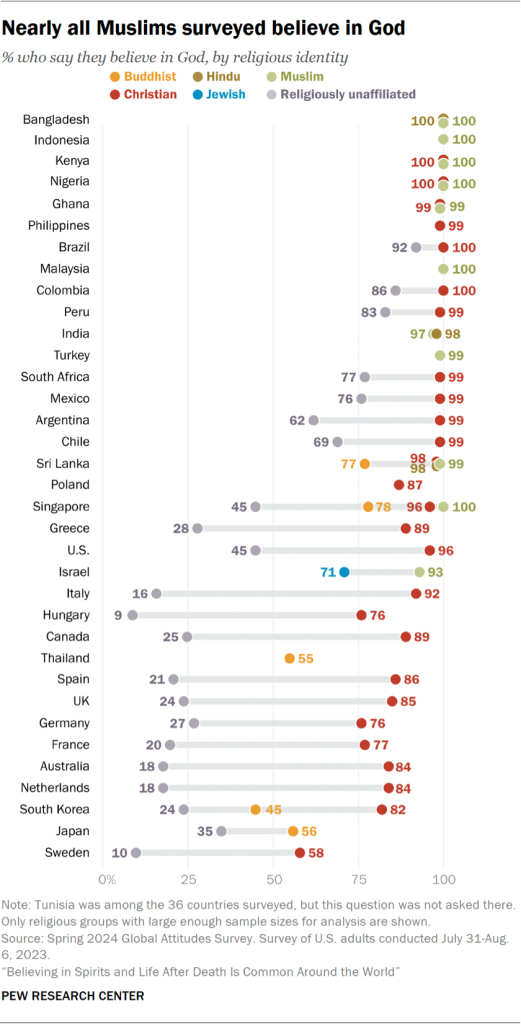
Large shares of Christians in most countries also say they believe in God. However, in Sweden, a relatively small majority of Christians (58%) believe in God.
And while large majorities of Buddhists in Singapore (78%) and Sri Lanka (77%) express a belief in God, fewer than half of South Korean Buddhists do so (45%).
Across the countries surveyed, the religiously unaffiliated – people who identify as atheist, agnostic or “nothing in particular”– are consistently the least likely to say they believe in God. Still, majorities of the unaffiliated in Latin America and South Africa believe in God. This includes 92% of Brazil’s religiously unaffiliated population.
Views by age
In general, adults ages 50 and older are more likely than those under 35 to say they believe in God. This divide is largest in Hungary and Italy.
In Hungary, a clear majority of the oldest adults (72%) believe in God, compared with fewer than half of adults under 35 (44%).
Meanwhile, in the U.S., 85% of adults ages 50 and older say they believe in God, while 66% of adults under 35 express the same belief.
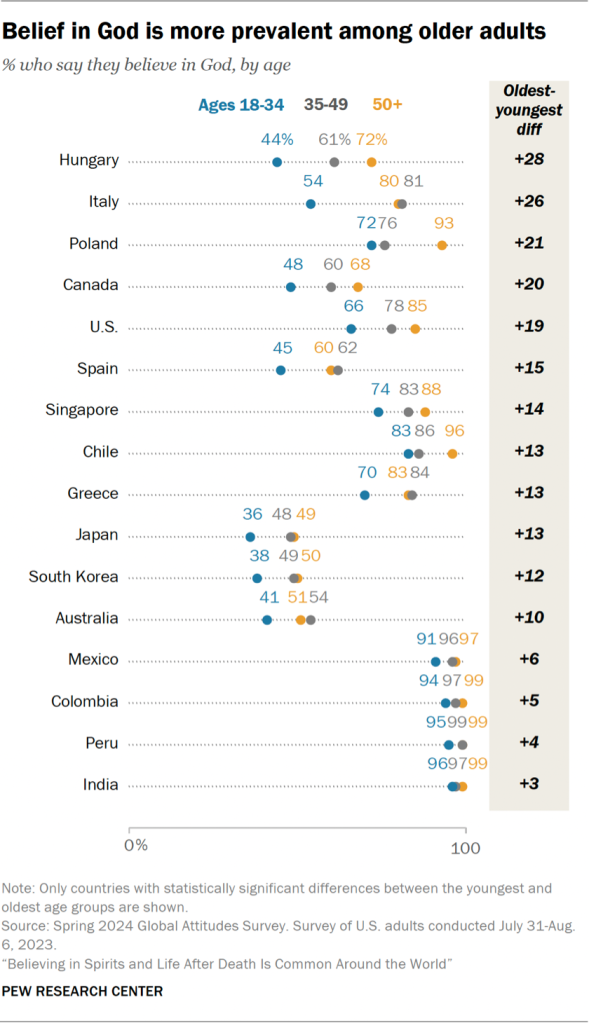
Views by education
In more than a dozen countries, adults with higher levels of education are less likely than other adults to believe in God.
For example, 64% of Israelis with a postsecondary education say they believe in God, compared with 83% of Israeli adults who have no more than a secondary education (the equivalent of high school in the United States).
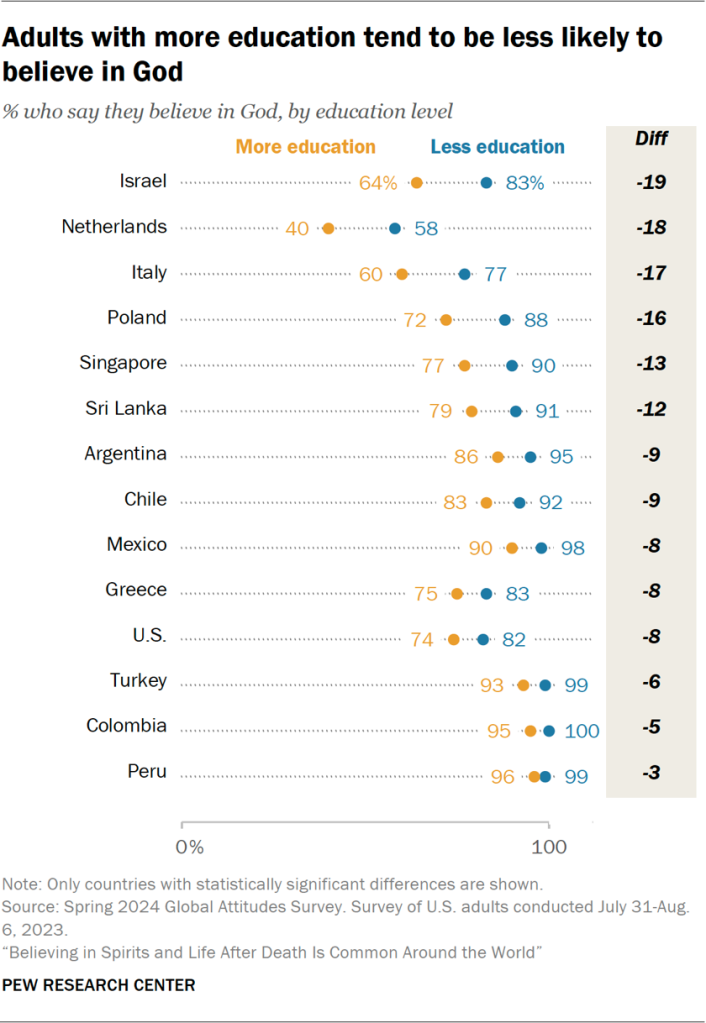
Spirits in animals
Most adults surveyed believe that animals can have spirits or spiritual energies, with a 35-country median of 62%.
This includes roughly eight-in-ten adults in India (83%), Greece (82%) and Turkey (81%).
Only in a handful of countries do fewer than half of adults say animals can have spirits or spiritual energies: Poland (43%), Kenya (42%), South Korea (42%), Bangladesh (40%) and Spain (36%).
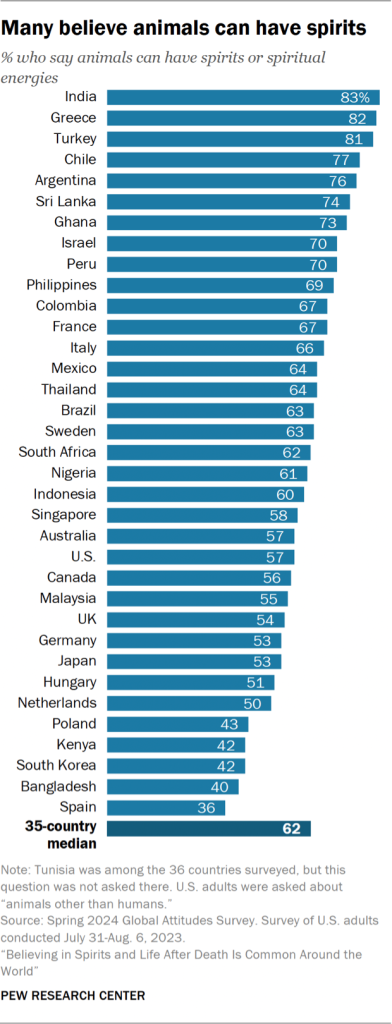
Views by religion
In general, similar shares of religiously unaffiliated adults (also known as religious “nones”) and Christians in each country say that animals can have spirits. In Greece, for instance, about eight-in-ten adults – among both Christians and the unaffiliated population – say this. And in the United Kingdom, about half in each group believes that animals can have spiritual energies.
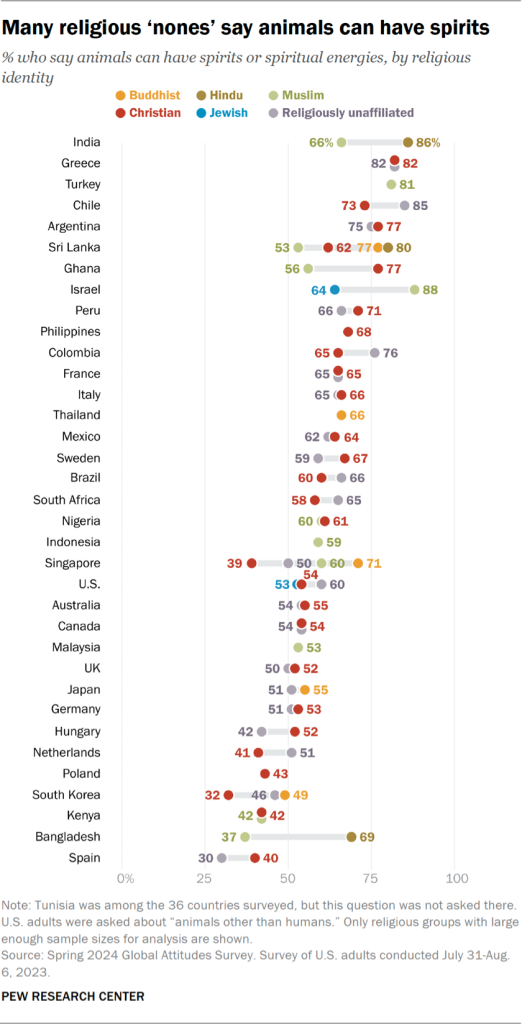
But in a handful of countries, the religiously unaffiliated are more likely than Christians to say that animals can have spiritual energies. For example, 85% of Chileans who do not identify with any religion say this, compared with 73% of Chilean Christians.
Muslims in different countries vary widely on this question, from a high of 88% of Israeli Muslims who say animals can have spirits to a low of 37% of Bangladeshi Muslims who share this view.
In all three countries with enough Hindus to analyze separately – Bangladesh, India and Sri Lanka – a large majority of Hindus say that animals can have spirits or spiritual energies.
Views by age
In general, the youngest adults are more likely than the oldest to say animals can have spirits. In Peru, about three-quarters of adults ages 18 to 34 (77%) say this, compared with only a slim majority of adults ages 50 and older (56%).
This division across age groups is the opposite of the pattern that exists on belief in God, where the oldest age group is more likely to believe than the youngest.
For a broader discussion about how age interacts with measures of spirituality and religion, read the Overview of this report.
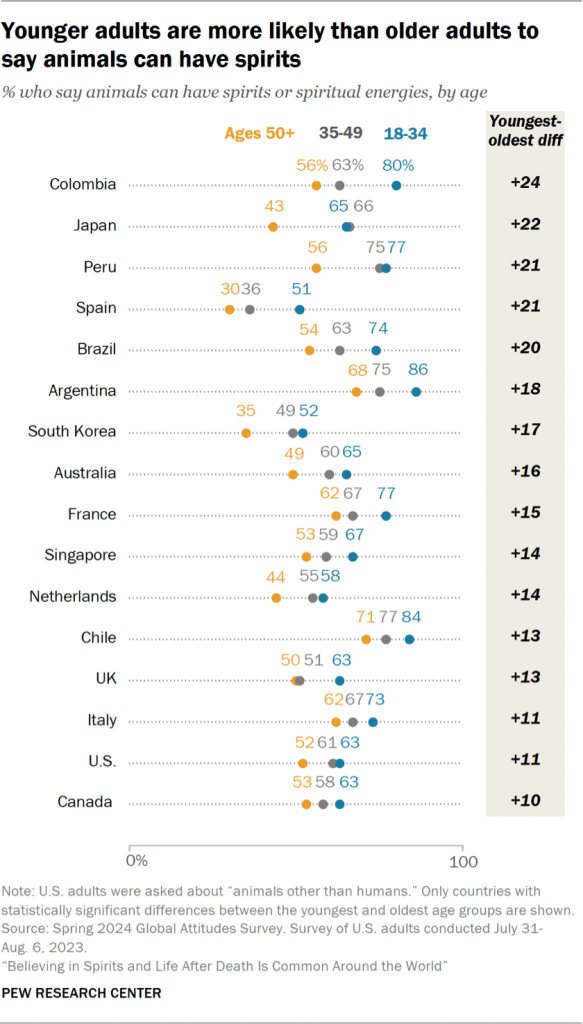
Spirits in nature
In about half of the countries surveyed, most respondents say that parts of nature (such as mountains, rivers or trees) can have spirits or spiritual energies.
This belief is particularly common in Southeast Asia and Latin America. For instance, 73% of Filipino adults say parts of nature can have spiritual energies, as do 70% of Colombians.
Views are more split in sub-Saharan Africa and South Asia. On the one hand, the vast majority of adults in Ghana (87%) and India (79%) believe that spirits can inhabit mountains, rivers or trees. On the other hand, fewer than half of adults in Kenya (44%) and Bangladesh (38%) express the same belief.
In a few countries, only about three-in-ten adults say that parts of nature can have spiritual energies: Sweden (32%), Poland (29%) and Israel (28%).
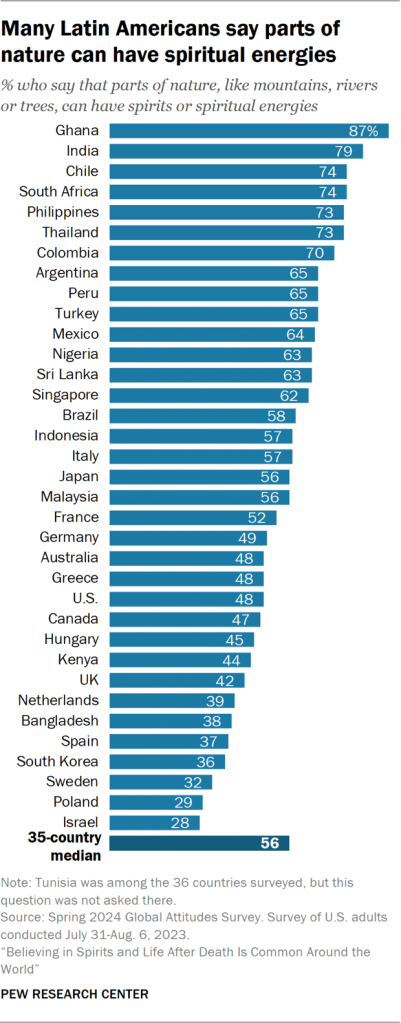
Views by religion
Hindus are the most likely to believe that parts of nature can have spirits. Half or more of Buddhists in all five countries with enough Buddhists to analyze (Japan, Singapore, South Korea, Sri Lanka and Thailand) also say this.
As with the belief that animals can have spirits, Christians and religiously unaffiliated populations in many countries voice similar attitudes about spiritual energies in nature. In Argentina, 65% of both Christians and religiously unaffiliated adults say parts of nature such as mountains, rivers and trees can have spirits.
In Israel, similar shares of Muslim (31%) and Jewish (27%) adults believe parts of nature can have spirits.

Views by gender
In some high-income countries, particularly in Europe, women are more likely than men to say that parts of nature can have spirits. For example, half of women in the UK say this, compared with around a third of men.
The gender gap is greatest in Australia, where 60% of women and 35% of men say parts of nature can have spiritual energies.
Among the middle-income countries surveyed, only Thailand and Turkey have a gender gap on this question.
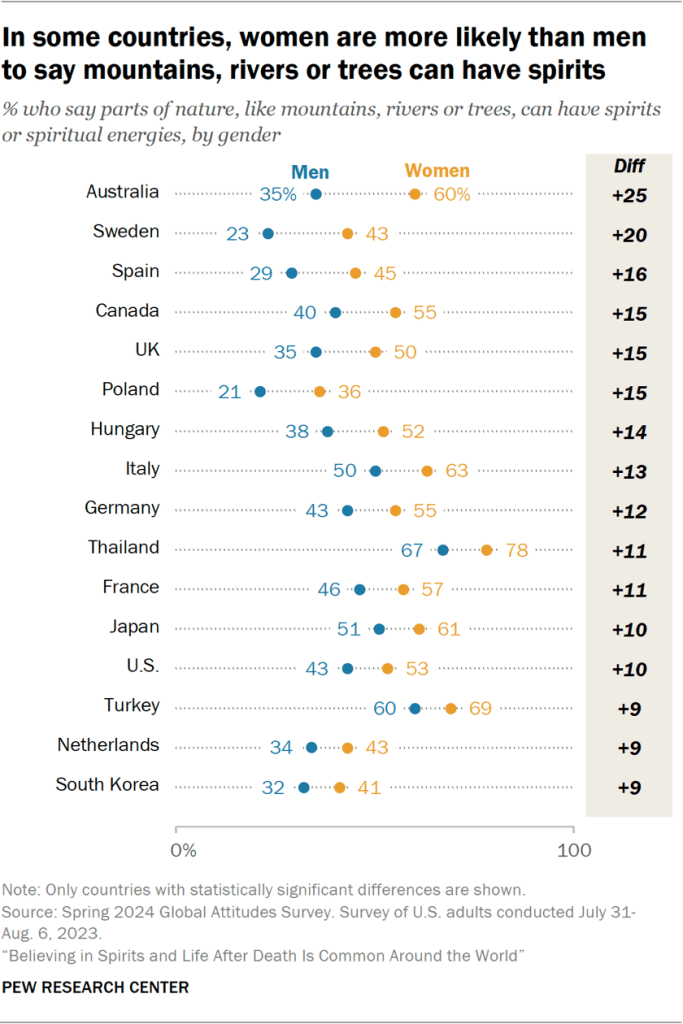
Spirits in objects
The belief that certain objects (such as crystals, jewels or stones) can have spirits or spiritual energies is far less common than the belief that animals or parts of nature can have spirits.
In nearly every country surveyed, fewer than half of adults say that such objects can have spirits.
People in Europe and East Asia are generally the least likely to say certain objects can have spiritual energies.
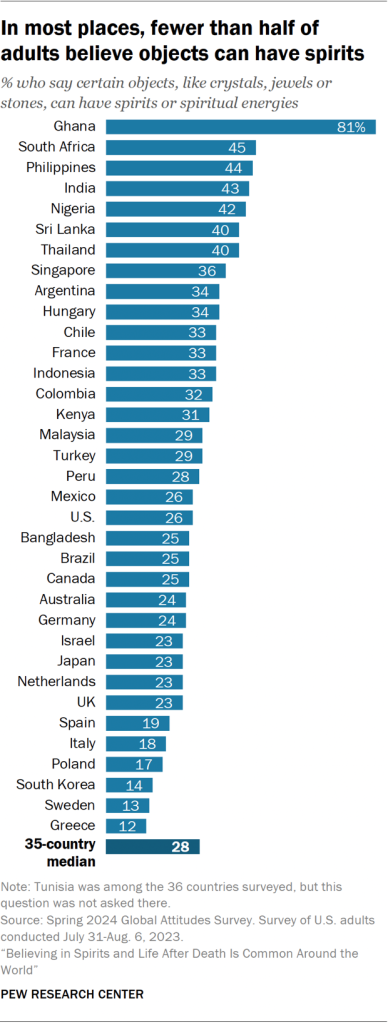
Views by religion
Within each country, respondents in different religious groups are often quite similar in their beliefs about objects having spirits. In Japan, for instance, equal shares of Buddhists and religiously unaffiliated adults say certain objects can have spiritual energies (22% each).
Still, in the three countries with large enough shares of Hindus to analyze separately, Hindus are the most likely to say there can be spiritual energies in objects such as crystals, jewels or stones. For instance, a majority of Sri Lankan Hindus (64%) say this, compared with about four-in-ten or fewer Sri Lankan Buddhists (39%), Christians (36%) and Muslims (25%).
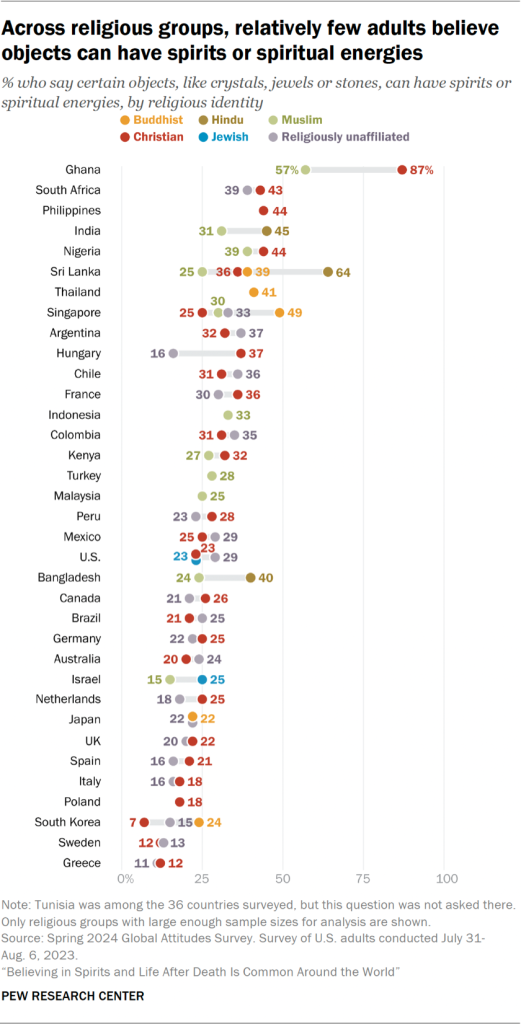
Spiritual presence beyond the natural world
Across most countries surveyed, the view that “there is something spiritual beyond the natural world, even if we cannot see it” is far more common than the view that “the natural world is all there is.”
Vast majorities of adults in Ghana (86%), Turkey (82%) and the U.S. (79%) say there is something spiritual beyond this world.
In just a few countries, respondents are more likely to take the contrasting view – that the natural world is all there is. The Philippines is the only country where a clear majority take this position (59%).
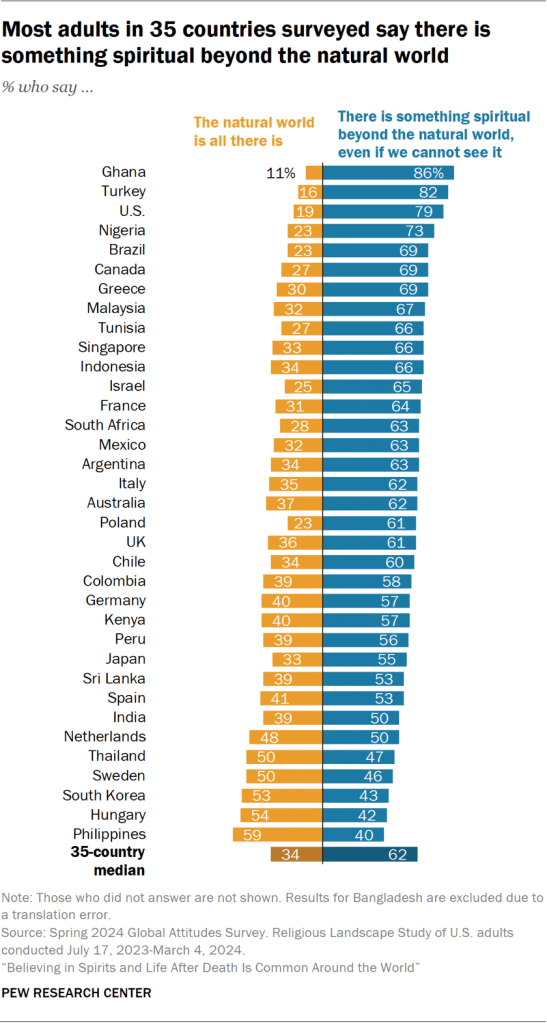
Views by religion
In general, Christians are more likely than other religious groups to say there is something spiritual beyond the natural world.

For example, Christians in Canada are more likely than religiously unaffiliated adults there to say this (82% vs. 53%).
Religiously unaffiliated people tend to be the least likely to say there is something spiritual beyond the natural world. Nevertheless, around half or more of the unaffiliated in 12 countries believe there is something spiritual beyond the natural world. This includes majorities of the unaffiliated populations in Brazil (65%), Mexico (61%), Chile (58%), Colombia (58%) and the U.S. (57%).
Clear – and even large – majorities of Muslims in most countries with sufficient sample sizes for analysis say that there is something spiritual beyond the natural world. However, fewer than half of Muslims in Kenya (44%) hold this belief.
Among Hindus, belief in something spiritual beyond the natural world ranges from 69% in the U.S. to 50% in India. Among Buddhists, it ranges from as high as 70% in the U.S. to as low as 47% in both South Korea and Thailand.
Views by rate of prayer
In most of the countries surveyed, adults who pray daily are more likely than those who pray less often to believe there is something spiritual beyond the natural world.
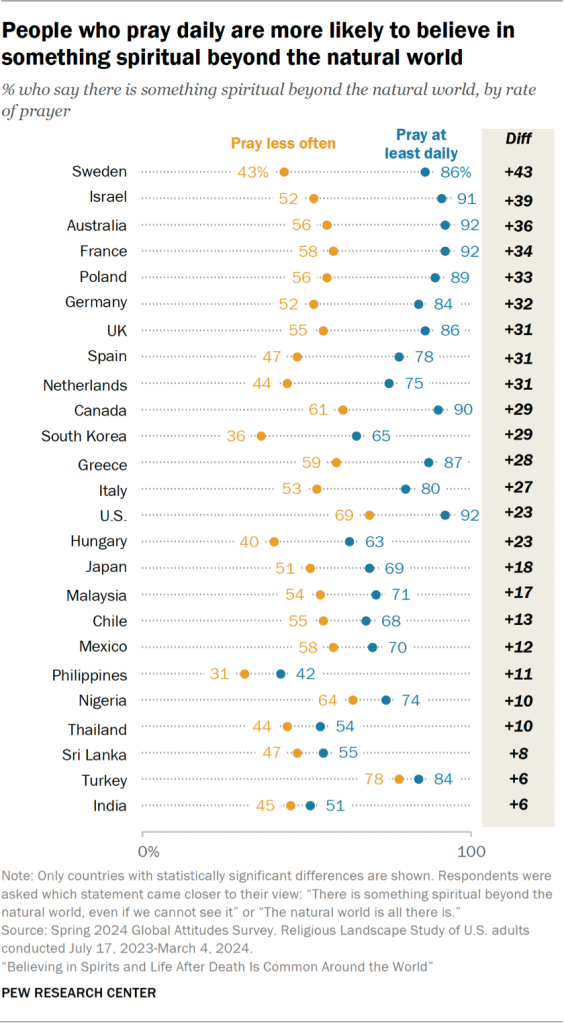
For instance, 91% of Israelis who pray at least once a day say there is something spiritual beyond the natural world, compared with 52% of Israelis who pray less often.
This divide is particularly large across Europe: France, Germany, the Netherlands, Poland, Spain, Sweden and the UK all have differences of at least 30 percentage points on this question between those who pray daily and those who pray less often.
There is a similar divide for belief in God: In nearly all countries surveyed, people who pray daily are considerably more likely than other adults to believe in God. This strong pattern does not appear in responses to the other questions discussed in this chapter.
Views by education
Adults with more education are more likely to believe in something spiritual beyond the natural world. (This is the opposite of the pattern observed on the question about belief in God.)
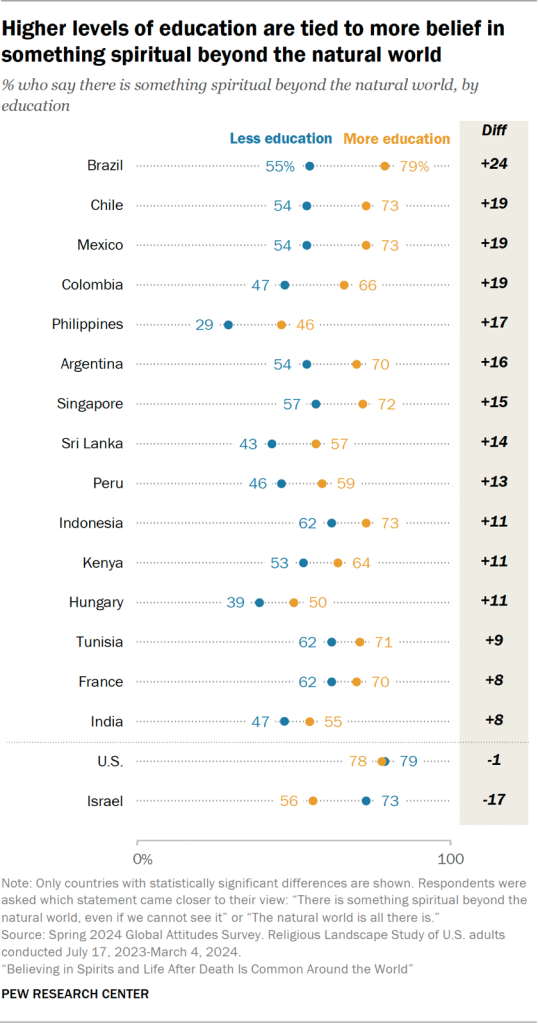
For example, 73% of Chileans who have completed postsecondary education say there is something spiritual beyond the natural world, while 54% of Chileans with less education say the same.
Israel is a notable exception to this pattern. Israeli adults with a postsecondary education, for instance, are less likely than those without as much education to say there is something spiritual beyond the natural world (56% vs. 73%).




